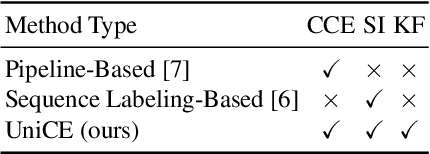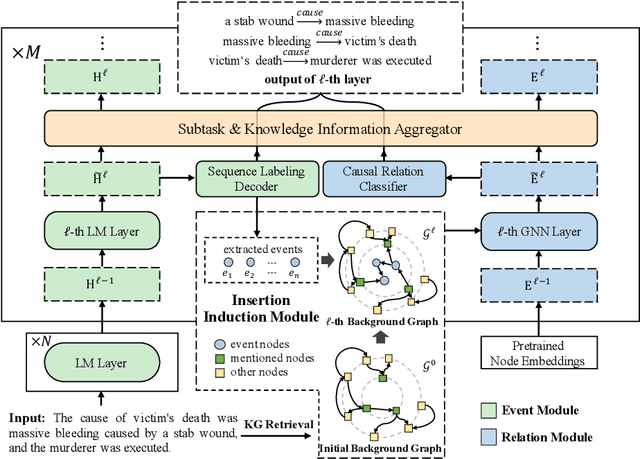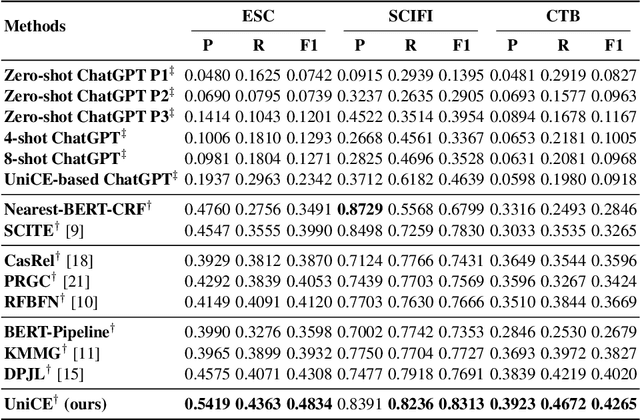Zhongyang Li
Bridging the Long-Term Gap: A Memory-Active Policy for Multi-Session Task-Oriented Dialogue
May 26, 2025Abstract:Existing Task-Oriented Dialogue (TOD) systems primarily focus on single-session dialogues, limiting their effectiveness in long-term memory augmentation. To address this challenge, we introduce a MS-TOD dataset, the first multi-session TOD dataset designed to retain long-term memory across sessions, enabling fewer turns and more efficient task completion. This defines a new benchmark task for evaluating long-term memory in multi-session TOD. Based on this new dataset, we propose a Memory-Active Policy (MAP) that improves multi-session dialogue efficiency through a two-stage approach. 1) Memory-Guided Dialogue Planning retrieves intent-aligned history, identifies key QA units via a memory judger, refines them by removing redundant questions, and generates responses based on the reconstructed memory. 2) Proactive Response Strategy detects and correct errors or omissions, ensuring efficient and accurate task completion. We evaluate MAP on MS-TOD dataset, focusing on response quality and effectiveness of the proactive strategy. Experiments on MS-TOD demonstrate that MAP significantly improves task success and turn efficiency in multi-session scenarios, while maintaining competitive performance on conventional single-session tasks.
MemEngine: A Unified and Modular Library for Developing Advanced Memory of LLM-based Agents
May 04, 2025Abstract:Recently, large language model based (LLM-based) agents have been widely applied across various fields. As a critical part, their memory capabilities have captured significant interest from both industrial and academic communities. Despite the proposal of many advanced memory models in recent research, however, there remains a lack of unified implementations under a general framework. To address this issue, we develop a unified and modular library for developing advanced memory models of LLM-based agents, called MemEngine. Based on our framework, we implement abundant memory models from recent research works. Additionally, our library facilitates convenient and extensible memory development, and offers user-friendly and pluggable memory usage. For benefiting our community, we have made our project publicly available at https://github.com/nuster1128/MemEngine.
C3PO: Critical-Layer, Core-Expert, Collaborative Pathway Optimization for Test-Time Expert Re-Mixing
Apr 10, 2025



Abstract:Mixture-of-Experts (MoE) Large Language Models (LLMs) suffer from severely sub-optimal expert pathways-our study reveals that naive expert selection learned from pretraining leaves a surprising 10-20% accuracy gap for improvement. Motivated by this observation, we develop a novel class of test-time optimization methods to re-weight or "re-mixing" the experts in different layers jointly for each test sample. Since the test sample's ground truth is unknown, we propose to optimize a surrogate objective defined by the sample's "successful neighbors" from a reference set of samples. We introduce three surrogates and algorithms based on mode-finding, kernel regression, and the average loss of similar reference samples/tasks. To reduce the cost of optimizing whole pathways, we apply our algorithms merely to the core experts' mixing weights in critical layers, which enjoy similar performance but save significant computation. This leads to "Critical-Layer, Core-Expert, Collaborative Pathway Optimization (C3PO)". We apply C3PO to two recent MoE LLMs and examine it on six widely-used benchmarks. It consistently improves the base model by 7-15% in accuracy and outperforms widely used test-time learning baselines, e.g., in-context learning and prompt/prefix tuning, by a large margin. Moreover, C3PO enables MoE LLMs with 1-3B active parameters to outperform LLMs of 7-9B parameters, hence improving MoE's advantages on efficiency. Our thorough ablation study further sheds novel insights on achieving test-time improvement on MoE.
EventWeave: A Dynamic Framework for Capturing Core and Supporting Events in Dialogue Systems
Mar 29, 2025Abstract:Existing large language models (LLMs) have shown remarkable progress in dialogue systems. However, many approaches still overlook the fundamental role of events throughout multi-turn interactions, leading to \textbf{incomplete context tracking}. Without tracking these events, dialogue systems often lose coherence and miss subtle shifts in user intent, causing disjointed responses. To bridge this gap, we present \textbf{EventWeave}, an event-centric framework that identifies and updates both core and supporting events as the conversation unfolds. Specifically, we organize these events into a dynamic event graph, which represents the interplay between \textbf{core events} that shape the primary idea and \textbf{supporting events} that provide critical context during the whole dialogue. By leveraging this dynamic graph, EventWeave helps models focus on the most relevant events when generating responses, thus avoiding repeated visits of the entire dialogue history. Experimental results on two benchmark datasets show that EventWeave improves response quality and event relevance without fine-tuning.
A Survey on Transformer Context Extension: Approaches and Evaluation
Mar 17, 2025Abstract:Large language models (LLMs) based on Transformer have been widely applied in the filed of natural language processing (NLP), demonstrating strong performance, particularly in handling short text tasks. However, when it comes to long context scenarios, the performance of LLMs degrades due to some challenges. To alleviate this phenomenon, there is a number of work proposed recently. In this survey, we first list the challenges of applying pre-trained LLMs to process long contexts. Then systematically review the approaches related to long context and propose our taxonomy categorizing them into four main types: positional encoding, context compression, retrieval augmented, and attention pattern. In addition to the approaches, we focus on the evaluation of long context, organizing relevant data, tasks, and metrics based on existing long context benchmarks. Finally, we summarize unresolved issues in the long context domain and put forward our views on future developments.
R2-T2: Re-Routing in Test-Time for Multimodal Mixture-of-Experts
Feb 27, 2025



Abstract:In large multimodal models (LMMs), the perception of non-language modalities (e.g., visual representations) is usually not on par with the large language models (LLMs)' powerful reasoning capabilities, deterring LMMs' performance on challenging downstream tasks. This weakness has been recently mitigated by replacing the vision encoder with a mixture-of-experts (MoE), which provides rich, multi-granularity, and diverse representations required by diverse downstream tasks. The performance of multimodal MoE largely depends on its router, which reweights and mixes the representations of different experts for each input. However, we find that the end-to-end trained router does not always produce the optimal routing weights for every test sample. To bridge the gap, we propose a novel and efficient method "Re-Routing in Test-Time(R2-T2) that locally optimizes the vector of routing weights in test-time by moving it toward those vectors of the correctly predicted samples in a neighborhood of the test sample. We propose three R2-T2 strategies with different optimization objectives and neighbor-search spaces. R2-T2 consistently and greatly improves state-of-the-art LMMs' performance on challenging benchmarks of diverse tasks, without training any base-model parameters.
A Survey of Personalized Large Language Models: Progress and Future Directions
Feb 17, 2025Abstract:Large Language Models (LLMs) excel in handling general knowledge tasks, yet they struggle with user-specific personalization, such as understanding individual emotions, writing styles, and preferences. Personalized Large Language Models (PLLMs) tackle these challenges by leveraging individual user data, such as user profiles, historical dialogues, content, and interactions, to deliver responses that are contextually relevant and tailored to each user's specific needs. This is a highly valuable research topic, as PLLMs can significantly enhance user satisfaction and have broad applications in conversational agents, recommendation systems, emotion recognition, medical assistants, and more. This survey reviews recent advancements in PLLMs from three technical perspectives: prompting for personalized context (input level), finetuning for personalized adapters (model level), and alignment for personalized preferences (objective level). To provide deeper insights, we also discuss current limitations and outline several promising directions for future research. Updated information about this survey can be found at the https://github.com/JiahongLiu21/Awesome-Personalized-Large-Language-Models.
VAGeo: View-specific Attention for Cross-View Object Geo-Localization
Jan 13, 2025



Abstract:Cross-view object geo-localization (CVOGL) aims to locate an object of interest in a captured ground- or drone-view image within the satellite image. However, existing works treat ground-view and drone-view query images equivalently, overlooking their inherent viewpoint discrepancies and the spatial correlation between the query image and the satellite-view reference image. To this end, this paper proposes a novel View-specific Attention Geo-localization method (VAGeo) for accurate CVOGL. Specifically, VAGeo contains two key modules: view-specific positional encoding (VSPE) module and channel-spatial hybrid attention (CSHA) module. In object-level, according to the characteristics of different viewpoints of ground and drone query images, viewpoint-specific positional codings are designed to more accurately identify the click-point object of the query image in the VSPE module. In feature-level, a hybrid attention in the CSHA module is introduced by combining channel attention and spatial attention mechanisms simultaneously for learning discriminative features. Extensive experimental results demonstrate that the proposed VAGeo gains a significant performance improvement, i.e., improving acc@0.25/acc@0.5 on the CVOGL dataset from 45.43%/42.24% to 48.21%/45.22% for ground-view, and from 61.97%/57.66% to 66.19%/61.87% for drone-view.
Crafting Personalized Agents through Retrieval-Augmented Generation on Editable Memory Graphs
Sep 28, 2024Abstract:In the age of mobile internet, user data, often referred to as memories, is continuously generated on personal devices. Effectively managing and utilizing this data to deliver services to users is a compelling research topic. In this paper, we introduce a novel task of crafting personalized agents powered by large language models (LLMs), which utilize a user's smartphone memories to enhance downstream applications with advanced LLM capabilities. To achieve this goal, we introduce EMG-RAG, a solution that combines Retrieval-Augmented Generation (RAG) techniques with an Editable Memory Graph (EMG). This approach is further optimized using Reinforcement Learning to address three distinct challenges: data collection, editability, and selectability. Extensive experiments on a real-world dataset validate the effectiveness of EMG-RAG, achieving an improvement of approximately 10% over the best existing approach. Additionally, the personalized agents have been transferred into a real smartphone AI assistant, which leads to enhanced usability.
Enhancing Complex Causality Extraction via Improved Subtask Interaction and Knowledge Fusion
Aug 06, 2024



Abstract:Event Causality Extraction (ECE) aims at extracting causal event pairs from texts. Despite ChatGPT's recent success, fine-tuning small models remains the best approach for the ECE task. However, existing fine-tuning based ECE methods cannot address all three key challenges in ECE simultaneously: 1) Complex Causality Extraction, where multiple causal-effect pairs occur within a single sentence; 2) Subtask~ Interaction, which involves modeling the mutual dependence between the two subtasks of ECE, i.e., extracting events and identifying the causal relationship between extracted events; and 3) Knowledge Fusion, which requires effectively fusing the knowledge in two modalities, i.e., the expressive pretrained language models and the structured knowledge graphs. In this paper, we propose a unified ECE framework (UniCE to address all three issues in ECE simultaneously. Specifically, we design a subtask interaction mechanism to enable mutual interaction between the two ECE subtasks. Besides, we design a knowledge fusion mechanism to fuse knowledge in the two modalities. Furthermore, we employ separate decoders for each subtask to facilitate complex causality extraction. Experiments on three benchmark datasets demonstrate that our method achieves state-of-the-art performance and outperforms ChatGPT with a margin of at least 30% F1-score. More importantly, our model can also be used to effectively improve the ECE performance of ChatGPT via in-context learning.
 Add to Chrome
Add to Chrome Add to Firefox
Add to Firefox Add to Edge
Add to Edge